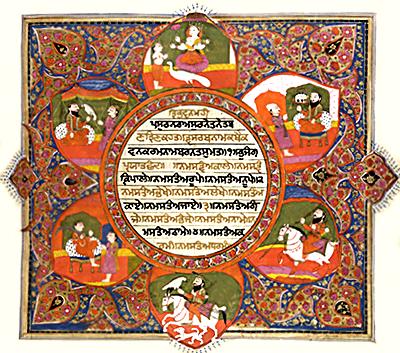Roh ke ruhele magh des ke maghele bir bun si bundele paap punj ke malat hae(n)
Gokha gun gaave Cheen matcheen ke sees niyavae tibatee dhiyae dokh deh ko dalat hae(n)
Jinae tohi dhiahyo tinae pooran prataap paayo sarab dhaan dhaam fel fool so falat hae(n)
Payee naa paar tej punj mae apaar sarab bidya ke udaar hae(n) apaar kahiyat haen”---Dasam Granth (pages 89-90)
Literally rendered, these lines tell us:
“The Bengalis of Bengal, the Phirangis of Phirangistan and Dilwalis of Delhi are your followers.
The Rohelas of Rohu mountain, the Maghelas of Magadha, the heroic Bangasis of Bangas and the Bundhelas of Bundhelkhand destroy their sins in thy devotion.
Gorkhas sing thy praises, the residents of China and Manchuria bow their heads before thee and the Tibetans destroy their own sufferings by remembering thee.Those who meditate on thee obtain perfect glory, and prosper greatly.
One cannot know thy limit, O Infinitely Glorious Lord! Thou art the Giver of all, therefore thou are Boundless.”
 This verse is from the work popularly known as the
Dasam Granth. Many Sikhs swear that every word in it is in fact the authentic
writing of Guru Gobind Singh. Others
reject this thesis either in toto or, at least, in significant parts. Dasam Granth has a controversial place in
Sikh psyche, history and tradition. It
is a large body of over 2300 pages of poetry.
Scholars as well as the larger Sikh community agree that many parts of
it are the authentic writings of Guru Gobind Singh but that they also appear mixed
with compositions that may not be his but come from various sources of that
time.
This verse is from the work popularly known as the
Dasam Granth. Many Sikhs swear that every word in it is in fact the authentic
writing of Guru Gobind Singh. Others
reject this thesis either in toto or, at least, in significant parts. Dasam Granth has a controversial place in
Sikh psyche, history and tradition. It
is a large body of over 2300 pages of poetry.
Scholars as well as the larger Sikh community agree that many parts of
it are the authentic writings of Guru Gobind Singh but that they also appear mixed
with compositions that may not be his but come from various sources of that
time.
It is also true that, as universally accepted by most Sikhs, the repository of our spiritual heritage is the Guru Granth and not the Dasam Granth. However, what cannot be denied is that the contents of the latter work are a significant part of Sikh culture and literature, hence deserving of Sikh conversation and dialogue.
I readily concede that I don’t really know who the author of the above cited lines is; it may be a matter of furious disagreement. But I don’t intend to step into those murky waters today. The authenticity of the Dasam Granth is not the topic here; I have briefly reported my non-scholarly take on it elsewhere. Today, let us set aside the question of who may have penned these lines.
Why then do these particular lines catch my eye today?
To me they speak of the universality of the Sikh message beyond the territory and self-limiting boundaries of Punjab. And this universality is entirely consistent with Sikh teaching and practice from Guru Nanak to Guru Gobind Singh.
In the first line the poet speaks of farangees; in common Punjabi parlance the word stands for foreigners, usually Whites. This verse was surely written before the influx of Europeans, the vast majority of whom came by sea sometimes in the 17th century. A limited number of Greek invaders had come with Alexander the Great but centuries earlier in about 325 BC. The remaining lines, too, focus on the common theme of a diverse humanity, somewhat like the theme inherent in the time honored motto E Pluribus Unum of the United States.
This colorful verse also echoes a hymn ascribed to Guru Gobind Singh that, in translation says “As out of a single fire millions of sparks arise, arise in separation, but come together again when they fall back into the fire; so from God’s form emerges all creation” (Akal Ustat, 87).
And then contrast this poet’s vision with the limited perspectives of our national (and wannabe international) leaders, particularly in the United States today.
In the United States a national election is coming soon that will anoint a new President – leader of the free world. I can’t but cringe when I look at the slew of candidates. A decade ago George W. Bush didn’t know where Iraq or Pakistan were when he became President in 2000; Sarah Palin, hoping to become the Vice President eight years later claimed to be able to see Russia from her house in Alaska, and that was the extent of her experience of the world. And then there was Herman Cain who unabashedly brandished his ignorance of the nations that may be trouble spots for us. And let me leave untouched the blind spots in Ron Perry’s perspective of the world.
These people want to run the world, while they know not what the world is and proudly flaunt their incoherence.
So I ask you to pause a moment and admire the worldview of the unknown poet who composed the lines that we started with today and think of the ordinary people -- his Sikh listeners about 300 years ago. The words are meant to be all embracing.
I bring this to you today because over the past decade or two I have been increasingly confronted with a very uncomfortable reality – of a narrowing definition and limited expanse of the Sikh worldview that our scholars and spokespersons often spout these days.
Look at Sikh history. Guru Nanak traveled widely. He often conveyed his message through music that transcends the bounds and context of language, time and culture. But he must have also engaged the people wherever he went. What language do you think he used? The local argot or the Punjabi of his native village? Keep in mind that he traveled as far as Tibet, Sri Lanka, the Middle East (Iraq and neighboring territories); other Gurus, particularly Guru Tegh Bahadur and Guru Gobind Singh traveled in Southern (Nander) and Eastern (Assam, Bihar) parts of India as well.
The Gurus traveled well beyond the limits of Punjab as well as Punjabi language and culture. We get some idea of how many languages, cultures and dialects the Gurus encountered in their travels by their compositions in the Guru Granth.
The Guru Granth gives us poetical output in many of the Indic languages as well as in Arabic and Persian. There are Muslim and Hindu poets represented, many of whom would never sit together, break bread together or be caught on the adjoining pages of the same holy book – until Guru Arjan in 1604 brought them together in the Adi Granth, the precursor of the Guru Granth.
If Judeo-Christian sacred literature had been as easily available in the India of that time I am sure some would have found commentary and inclusion in the Guru Granth. History suggests that a Muslim saint, Mia(n) Mir laid the foundation stone of the Golden Temple (Harimander Sahib) at Amritsar, the defining marker of Sikh history and psyche today.
 So when we speak proudly of the catholicity and
universality of the message of the Sikh Gurus it is not just idle chatter.
So when we speak proudly of the catholicity and
universality of the message of the Sikh Gurus it is not just idle chatter.
Why then do we find granthis and so called experts on Sikhi aggressively insisting that within the gurduara premises only Punjabi may be spoken, and a speech in any other language, such as English, is unacceptable if not blasphemous? In this potent equation keep in mind that many young people, born or raised outside India, neither speak nor understand Punjabi beyond a rudimentary conversational level, if that.
(I say this and yet I recognize that if we don’t emphasize Punjabi language it will soon be relegated to the dustbin of history. The end of a language is nothing to celebrate for it also means the demise of a culture and its worldview. And that surely is not my intent today or ever.)
Look at Guru Amardas who established 22 diocesan centers (manjis) to spread the message of Sikhi far and wide. Forget not that they covered the expanse of the Indian subcontinent; heaven only know how many languages were represented. In the manji-holders there were eight women.
Guru Gobind Singh welcomed Hindu as well as Muslim allies like Pir Buddhu Shah. Cast a look at the seminal events of the Vaisakhi of 1699. When the Guru established the institution of the Khalsa by initiating the first five Sikhs (Punj Piyaray) where did they come from? Only one was from Punjab, the other four represented different castes and regions of India. How about Banda Bahadur whom Guru Gobind Singh deputed to lead his mission in Punjab? What were his antecedents? He was certainly no Punjabi.
But what do we see today?
Women are the forgotten half. Briefly put, they have almost no place within majority of the gurduaras today. In fact, we seem to have written them out of our history. I recall when we invited an unusually excellent woman granthi, Sat Kirin Kaur, to officiate at a wedding at a gurduara in New York, two asinine objections surfaced. Why a woman? And secondly, she was not of Punjabi descent, being a White Caucasian American.
In fact this last objection is how we often dismiss those who have converted to Sikhism but are not of Indian-Punjabi descent.
Sikhi, to me, is a message that is unique, universal, timeless, and a thinking person’s way of life but today we seem to have reduced it to Sikhi by inheritance and limited to Punjabi culture, cuisine, music and ambience.
Yet, the fact remains that it is largely Punjabi immigrant Sikhs who have founded gurduaras in the diaspora often to address their own nostalgic need of connecting with home.
The new Punjabi immigrant, perhaps not well or extensively schooled, is conscious of his Indian accent, his poor command over the local language and how it is handled by the natives; he is often unsure of his footing in the society around him and seen as an easy mark by the sharp local businessman. The immigrant is often paid less for the same work than his native born colleagues; often he is socially isolated and financially pressed. His attire, body language, conversation, and ignorance of issues that drive the local community betray him; even his Sikh appearance appears as a handicap. And the post 9/11 reality does not help. His insecurity craves a social setting where he too can be himself. He needs his own comfort zone. And that’s why our gurduaras continue to look and run they way they do.
So, gurduaras in the diaspora function as they do in India to capture the sights smells and sounds of home and the home is Punjab. But for the children of immigrants who are growing up outside their extended families in a very different society it is a markedly different reality and for many of us the Punjabi connection does not hold; for many the home is now different as are its sights, smells and sounds.
(Parenthetically, I note that, at least in theory the larger mostly Hindu Indian culture has a very different, almost a paradoxically xenophobic, attitude to religion, culture and foreigners. I know it is rapidly changing in the global village that we all inhabit, but even now there are multitudes of Hindus that undergo a ritual purification whenever they return from travel beyond the seas. Even today, there exist Hindu temples where neither a non-Hindu nor a Hindu convert from a different race, such as White or Black, may enter.)
I am astounded at the tolerant, wide and rich world view in old Sikh literature. So, once again, please peruse the citation we started with and salute the inclusive and commanding vision of the unknown poet – a man way ahead of his times.
I.J. Singh [email protected]>
February 7, 2012

